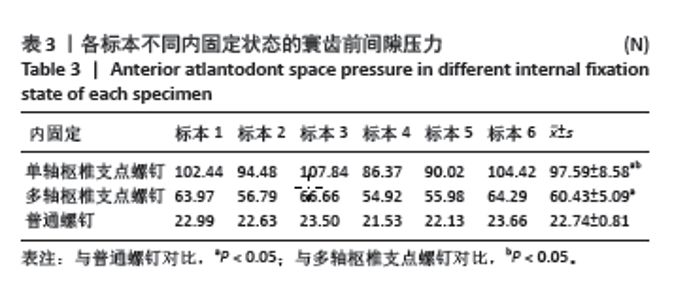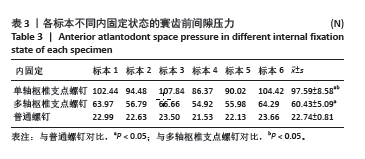[1] YIN QS, WANG JH. Current Trends in Management of Atlantoaxial Dislocation. Orthop Surg. 2015;7(3):189-199.
[2] 谭明生.寰枢椎脱位的中西医治疗[J].中国矫形外科杂志,2022, 30(21):1921-1924.
[3] 中国中西医结合学会脊柱医学专业委员会,谭明生,Atul Goel,等. 寰枢椎脱位中西医结合诊治指南(2019)[J].中国骨伤,2020,33(1): 27-38.
[4] XU J, YIN Q, XIA H, et al. New clinical classification system for atlantoaxial dislocation. Orthopedics. 2013;36:e95-e100.
[5] 江伟,张仕涛,方园,等.后路寰枢椎钉棒固定融合术治疗类风湿性寰枢椎脱位的临床效果[J].临床医学研究与实践,2021,6(17): 90-92.
[6] BHOWMICK DA, BENZEL EC. Posterior atlantoaxial fixation with screw-rod constructs: safety, advantages, and shortcomings. World Neurosurg. 2014;81(2):288-289.
[7] 邹小宝,马向阳,陈育岳,等.一期后路手术治疗可复性寰枢椎脱位合并下颈椎椎管狭窄[J].中国脊柱脊髓杂志,2021,31(1):1-7.
[8] QI L, LI M, ZHANG S, et al. C1-c2 pedicle screw fixation for treatment of old odontoid fractures. Orthopedics. 2015;38(2):94-100.
[9] 李文浩,张刘波,何昆,等.寰椎椎弓根螺钉技术治疗寰枢椎脱位的Meta分析[J].中日友好医院学报,2021,35(1):35-37.
[10] PENG X, CHEN L, WAN Y, et al. Treatment of primary basilar invagination by cervical traction and posterior instrumented reduction together with occipitocervical fusion. Spine (Phila Pa 1976). 2011;36:1528-1531.
[11] WANG C, YAN M, ZHOU HT, et al. Open reduction of irreducible atlantoaxial dislocation by transoral anterior atlantoaxial release and posterior internal fixation. Spine (Phila Pa 1976). 2006;31:E306-313.
[12] SRIVASTAVA SK, AGGARWAL RA, NEMADE PS, et al. Single-stage anterior release and posterior instrumented fusion for irreducible atlantoaxial dislocation with basilar invagination. Spine J. 2016;16:1-9.
[13] WEI G, WANG Z, AI F, et al. Treatment of Basilar Invagination With Klippel-Feil Syndrome: Atlantoaxial Joint Distraction and Fixation With Transoral Atlantoaxial Reduction Plate. Neurosurgery. 201678: 492-498.
[14] WEI G, SHI C, WANG Z, et al. Surgical Outcome and Prognostic Analysis of Transoral Atlantoaxial Reduction Plate System for Basilar Invagination: A Voxel-Based Morphometry Study. J Bone Joint Surg Am. 2016;98:1729-1734.
[15] TU Q, CHEN H, MA XY, et al. Usefulness of a Three-Dimensional-Printed Model in the Treatment of Irreducible Atlantoaxial Dislocation with Transoral Atlantoaxial Reduction Plate. Orthop Surg. 2021;13:799-811.
[16] 马向阳,杨进城,邱锋,等.不可复性寰枢椎脱位的临床分型及术式选择[J].中华骨科杂志,2015,35(5):474-480.
[17] 常恒瑞,李祥宇,赵若宇,等.后路寰枢椎固定技术的生物力学研究进展[J].中国脊柱脊髓杂志,2022,32(4):369-373.
[18] GUAN J, CHEN Z, WU H, et al. Effectiveness of posterior reduction and fixation in atlantoaxial dislocation: a retrospective cohort study of 135 patients with a treatment algorithm proposal. Eur Spine J. 2019; 28(5):1053-1063.
[19] 欧阳北平,马向阳,罗春山,等.新型钉尾横连在后路寰枢椎固定中的生物力学分析[J].中国组织工程研究,2023,28(12):1837-1841.
[20] 欧阳北平,马向阳,罗春山,等.不同横连模式后路寰枢椎椎弓根钉棒固定术治疗寰枢椎脱位的临床疗效[J].中国脊柱脊髓杂志, 2022,32(12):1112-1119.
[21] 常恒瑞,李祥宇,赵若宇,等.后路寰枢椎固定技术的生物力学研究进展[J].中国脊柱脊髓杂志,2022,32(4):369-373.
[22] 张颉鸿,卢一生.改良Brooks技术和寰枢椎椎弓根螺钉内固定系统生物力学特点[J].脊柱外科杂志,2022,20(1):39-44.
[23] 马向阳,杨进城,邹小宝,等.寰枢椎后路专用钉棒固定器械的研制与初步临床应用[J].中国骨科临床与基础研究杂志,2016,8(5): 261-268.
[24] 葛苏,邹小宝,马向阳,等.枢椎支点螺钉设计与其在寰枢椎脱位修复中的应用[J].中国组织工程研究,2020,24(9):1348-1352.
[25] MA XY, YIN QS, WU ZH, et al. Anatomic considerations for the pedicle screw placement in the first cervical vertebra. Spine (Phila Pa 1976). 2005;30(13):1519-1523.
[26] DAVIDSON CT, BERGIN PF, VARNEY ET, et al. Planning C2 pedicle screw placement with multiplanar reformatted cervical spine computed tomography. J Craniovertebr Junction Spine. 2019;10(1):46-50.
[27] 宁凡友,王冲,孔丽.寰枢椎脱位行寰枢椎后路融合手术后的下颈椎曲度变化情况及其预测因素[J].颈腰痛杂志,2021,42(6):763-767.
[28] ZHOU S, YUAN B, LIU W, et al. Three-dimensional reduction method with a modified C2 isthmus screw in irreducible atlantoaxial dislocation: a technical note. BMC Surg. 2021;21:324.
[29] LI C, TIAN Y, REN Q, et al. Treatment of Atlantoaxial Dislocation in Children with Down Syndrome Using Posterior Atlantoaxial Screw Fixation. Front Surg. 2022;9:877929.
[30] LIU HT, LIANG ZH, SONG J, et al. Posterior Atlantoaxial Fusion With C1-2 Pedicle Screw Fixation for Atlantoaxial Dislocation in Pediatric Patients With Mucopolysaccharidosis IVA (Morquio a Syndrome): A Case Series. World Neurosurg. 2023;175:e574-e581.
[31] 吴学元,郝崔培,凌鸣,等.颈后路内固定植骨融合术治疗寰枢椎脱位的疗效分析[J].实用骨科杂志,2022,28(9):821-826.
[32] WANG J, XU T, PU L, et al. Release, reduction, and fixation of one-stage posterior approach for basilar invagination with irreducible atlantoaxial dislocation. Br J Neurosurg. 2020:1-14. doi: 10.1080/02688697.2020.1861217.
[33] 左强,周全,胡靖,等.寰枢椎椎弓根螺钉固定融合疗法与后路寰枢椎经关节螺钉结合寰椎椎板钩固定融合疗法治疗寰枢椎脱位的临床疗效比较[J].临床和实验医学杂志,2022,21(6):618-621.
[34] LIU HT, LIANG ZH, SONG J, et al. Posterior Atlantoaxial Fusion With C1-2 Pedicle Screw Fixation for Atlantoaxial Dislocation in Pediatric Patients With Mucopolysaccharidosis IVA (Morquio a Syndrome): A Case Series. World Neurosurg. 2023;175:e574-e581.
[35] ZHAN J, XU W, LIN J, et al. Accuracy and Safety of Robot-Assisted versus Fluoroscopy-Guided Posterior C1 Lateral Mass and C2 Pedicle Screw Internal Fixation for Atlantoaxial Dislocation: A Preliminary Study. Biomed Res Int. 2022;2022:8508113.
[36] GUO Q, ZHOU X, GUO X, et al. C2 partial transpedicular screw technique for atlantoaxial dislocation with high-riding vertebral artery: A technique note with case series. Clin Neurol Neurosurg. 2021;200: 106403.
[37] SHEN Q, XIA Y, XU T. Clinical Outcomes of Atlantoaxial Dislocation Combined with Osteoporosis Using Posterior Atlantoaxial Rod, Screw Fixation, and Posterior Interfacet Fusion: A Retrospective Study of 21 Cases. Med Sci Monit. 2020;26:e925187.
[38] ZHOU X, LI S, LIU H, et al. Comparison of Two Bone Grafting Techniques Applied During Posterior C1-C2 Screw-Rod Fixation and Fusion for Treating Reducible Atlantoaxial Dislocation. World Neurosurg. 2020; 143:e253-e260.
[39] CHEN ZD, WU J, LU CW, et al. C1-C2 Pedicle Screw Fixation for Pediatric Atlantoaxial Dislocation: Initial Results and Long-term Follow-up. J Pediatr Orthop. 2020;40:65-70.
[40] SHAO J, GAO Y, GAO K, et al. Comparison of imaging parameters pre- and post- reductive procedure for atlantoaxial dislocation via posterior fixation using pedicle screw and rod: a cross-sectional study. BMC Musculoskelet Disord. 2019;20:451.
[41] WANG HW, YIN YH, LI T, et al. Effects of transverse connector on reduction and fixation of atlantoaxial dislocation and basilar invagination using posterior C1-C2 screw-rod technique. Spine J. 2019; 19:1995-2002.
[42] 刘昆,王洪业.平膜片式薄膜压力传感器的线性度与灵敏度分析[J].传感技术学报,1996(3):1-7. |

